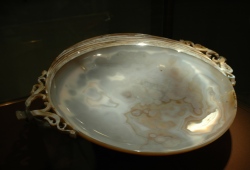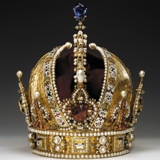The "Holy Grail"
 The legend of the Holy Grail is one of the central subjects of medieval literature and in particular it makes up an important segment of the Arthurian tale. The core of the Grail legend is the search for a miraculous spiritual object, which due to its special history symbolizes cultic mysticism and secrets and which gives different blessing including happiness and everlasting youth to the owner.
The legend of the Holy Grail is one of the central subjects of medieval literature and in particular it makes up an important segment of the Arthurian tale. The core of the Grail legend is the search for a miraculous spiritual object, which due to its special history symbolizes cultic mysticism and secrets and which gives different blessing including happiness and everlasting youth to the owner.
The Holy Grail is first featured in Perceval, an incomplete verse romance by Chrétien de Troyes, written sometime between 1179 and 1191 in Flanders. Later on Grail tales were written for instance by Robert de Boron, Wolfram von Eschenbach and Helinandus Frigidimontis. The common element shared by all Grail legends is that the Grail itself is described as a miraculous vessel in the form of a bowl, a chalice or a stone, guarded by the Grail King or Grail Knights in an inaccessible remote castle and waiting for an pure hero worthy to eliminate a - differently described - deficiency so that he brings salvation to the Grail community and is remunerated with the Holy Grail.
It was very early that the Holy Grail legend connected with the Christian Holy Communion: the Grail was interpreted to be the chalice, which Jesus Christ used for the Last Supper and where Joseph of Arimathea collected Christ's blood from the cross. Therefore the Grail figured among the numerous medieval blood-of-Christ relics, together with the Lance of Longinus, the Shroud of Turin, the Sudarium of Veronica and other relics.
Agate bowl in the Treasury Museum
In the Vienna Treasury Museum there is an agate bowl (Achatschale), which was probably captured during the conquest of Constantinople in 1204, later owned by Charles the Bold of Burgundy and eventually as Burgundy Inheritance integrated into the Habsburg treasury. From 17th to the 20th century, there were some descriptions of a mysterious inscription, which was seen as the name of Christ in Greek letters, neither carved in the stone nor painted, but to appear in the natural veining of the stone itself. Due to this special inscription, the Agate bowl was regarded as a relic, directly connected to Jesus Christ and referred to as the "Holy Grail".
Regardless of its spiritual significance, the Bowl is a piece of art: it consists of a single agate stone and with its diameter of 76 centimetres it is worldwide the largest bowl carved into a block of hard stone. The technical masterstroke to produce this artefact is almost inconceivable, as agate is harder than steel. Nevertheless the handles carved out of the stone seem to be made of wax.
Due to its special significance as well as its amazing size and magnificent craftsmanship, the Agate Bowl together with the "Ainkhürn" (a narwhale tusk, considered to be the horn of a unicorn) was declared "inalienable heirloom of the House of Habsburg" in the inheritance treaty of Emperor Ferdinand's I sons. It should be owned together by all members of the House of Habsburg and should be neither sold nor given away.
If you want to know more about the history of the "Holy Grail" in the Vienna Treasury Museum, you will get more detailed information during our fascinating guided tours to the Treasury Museum as well as the themed tour "The Da Vinci Code in Vienna" by DDr. Anna Ehrlich, one of the most famous arts and history writers in Austria.
